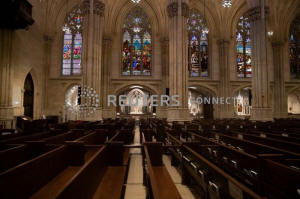Americans spend grim Easter Sunday at home as COVID-19 deaths near
22,000
 Send a link to a friend
Send a link to a friend
 [April 13, 2020]
By Barbara Goldberg and Dan Whitcomb [April 13, 2020]
By Barbara Goldberg and Dan Whitcomb
NEW YORK/LOS ANGELES (Reuters) - Americans
spent a glum Easter Sunday largely confined to their homes by the
still-raging coronavirus pandemic as the U.S. death toll neared 22,000,
with more than half a million confirmed cases nationwide.
With 42 states imposing strict stay-at-home orders most churches were
shuttered, although many erected crosses outside or even offered
drive-through services conducted by priests, pastors or ministers
wearing latex gloves and surgical masks.
Other Americans turned to online church services to mark the holiest day
in the Christian calendar.
In Louisiana, the evangelical Life Tabernacle megachurch near Baton
Rouge defied local government orders to shut down, holding its Easter
Sunday service as planned, said Reverend Tony Spell.

"Our rights come from our creator, not from a governing body," Spell
told Reuters, adding people traveled from across the region to attend.
In some states, attempts by authorities to clamp down on Easter services
have sparked legal battles over the rights of government to prevent
Americans from attending church, even under pandemic conditions.
On Saturday, the Kansas Supreme Court upheld an executive order barring
more than 10 people from gathering for religious and funeral services.
The decision, a victory for Democratic Governor Laura Kelly, followed an
attempt by a Republican-led legislative body to overturn the order.
The United States, with the world's third-largest population, has
recorded more fatalities from COVID-19 than any other country, nearly
22,000 as of Sunday evening according to a Reuters tally.
Roughly 2,000 deaths a day were reported for the last four days in a
row, the largest number in and around New York City. Even that is viewed
as understated, as New York is still figuring out how best to include a
surge in deaths at home in its official statistics.
(Graphic: Tracking the novel coronavirus in the U.S. - https://graphics.reuters.com/HEALTH-CORONAVIRUS-USA/0100B5K8423/index.html)
As the death toll has mounted, President Donald Trump mulled when the
country might begin to see a return to normality.

TRUMP EYES MAY 1
The sweeping restrictions on non-essential movement now applied to most
Americans have damaged the economy, taken a painful toll on commerce and
raised questions over how long business closures and travel curbs can be
sustained.
The number of Americans seeking unemployment benefits in the last three
weeks surpassed 16 million.
The Trump administration sees May 1 as a potential date for easing the
restrictions, the commissioner of the Food and Drug Administration,
Stephen Hahn, said on Sunday. But he cautioned that it was still too
early to say whether that goal would be met.
[to top of second column]
|

Empty seats are seen during an Easter service at St. Patrick's
Cathedral as the outbreak of the coronavirus disease (COVID-19)
continues in the Manhattan borough of New York City, New York, U.S.,
April 12, 2020. REUTERS/Jeenah Moon

"We see light at the end of the tunnel," Hahn told ABC's "This
Week," adding, "Public safety and the welfare of the American people
has to come first. That has to ultimately drive these decisions."
In the latest sign of the disruption wrought by the disease, one of
the nation's largest pork processing plants was shuttered after
workers fell ill, and its owner warned the country was moving
"perilously close to the edge" in supplies for grocers.
"It is impossible to keep our grocery stores stocked if our plants
are not running," Ken Sullivan, chief executive of Smithfield Foods,
said in a statement on Sunday.
Dozens of workers at a beef production plant in Greeley, Colorado,
have tested positive for COVID-19, according to its owner,
meatpacking company JBS USA. The union representing workers at the
plant said two employees have died.
In recent days, public health experts and some governors have
pointed to some hopeful signs that the worst of the pandemic might
be past.
Dr. Anthony Fauci, the country's top U.S. infectious disease expert,
said he was cautiously optimistic and pointed to the New York
metropolitan area, which had its highest daily death toll last week
but also saw a decrease in hospitalizations, intensive care
admissions and the need to intubate critically ill patients.

"Once you turn that corner, hopefully you'll see a very sharp
decline and then you can start thinking about how we can keep it
that way," Fauci told CNN's "State of the Union."
"If all of a sudden we decide 'OK, it's May whatever,' and we just
turn the switch on, that could be a real problem."
Fauci and other public health experts say widespread testing will be
key to efforts to reopen the economy, including antibody tests to
find out who has already had the disease and could be safe to return
to work.
New government data shows a summer surge in infections if
stay-at-home orders are lifted after only 30 days, according to
projections first reported by the New York Times and confirmed by a
Department of Homeland Security official.
(Reporting by Barbara Goldberg, Tom Polansek, Katie Paul, Doina
Chiacu, Ross Colvin, Noeleen Walder, Christopher Bing and Lisa
Shumaker; Writing by Dan Whitcomb; Editing by Diane Craft and Daniel
Wallis)
[© 2020 Thomson Reuters. All rights
reserved.] Copyright 2020 Reuters. All rights reserved. This material may not be published,
broadcast, rewritten or redistributed.
Thompson Reuters is solely responsible for this content.
 |